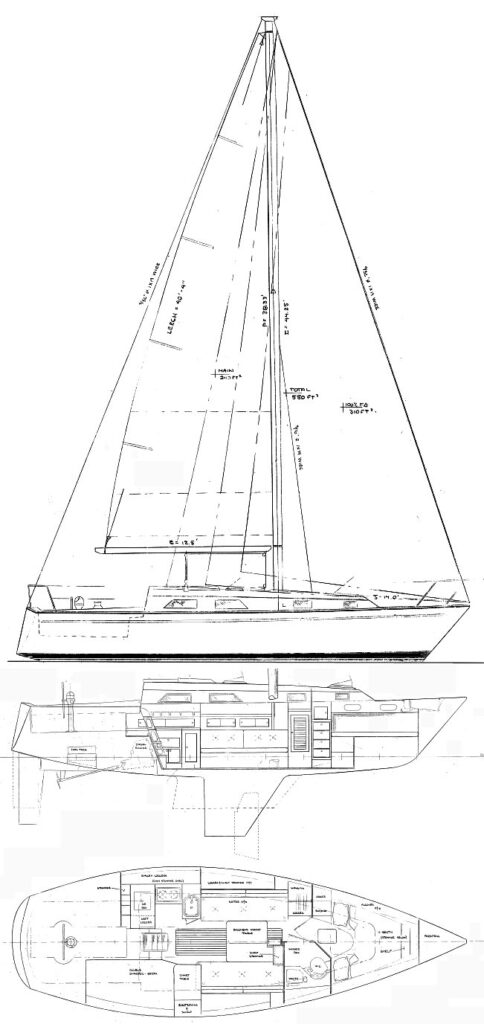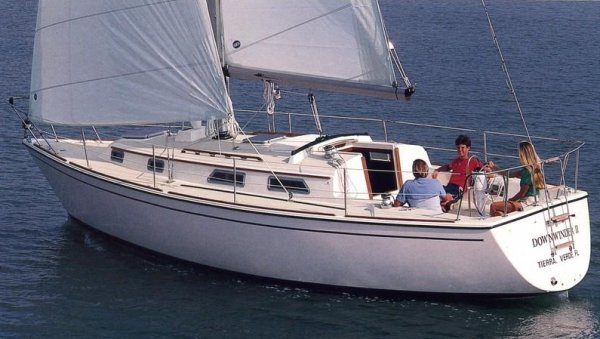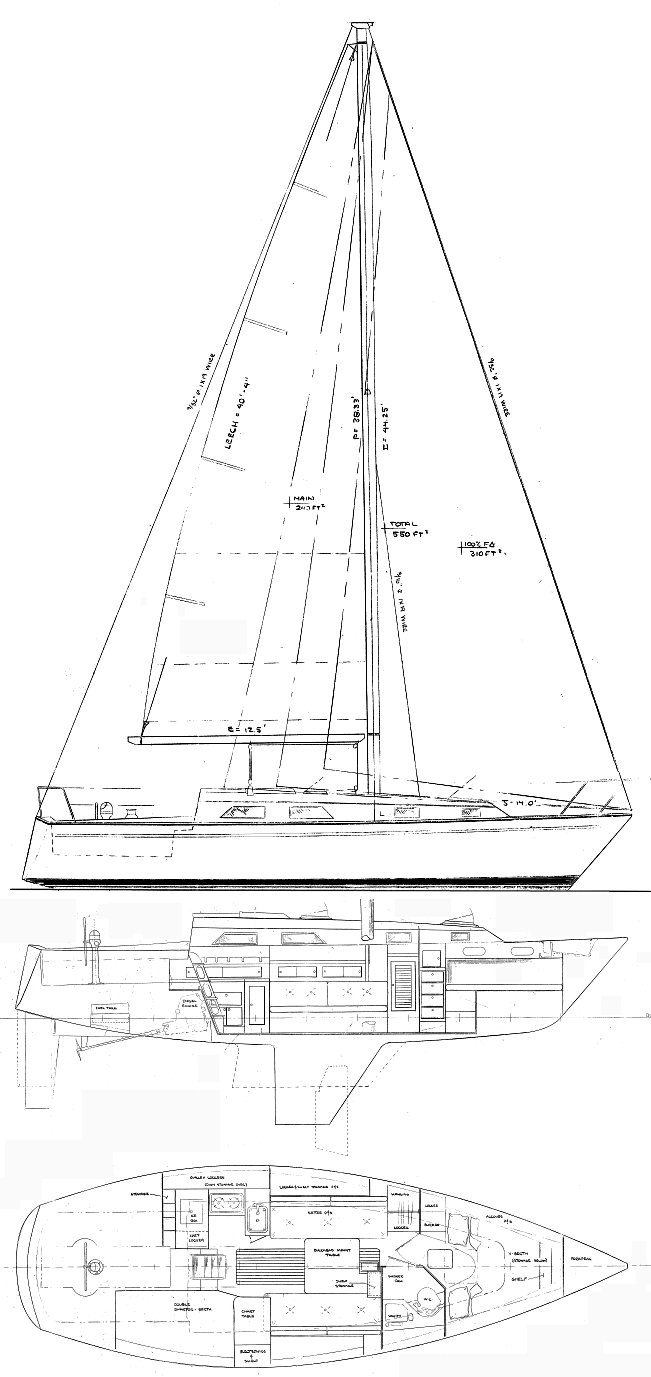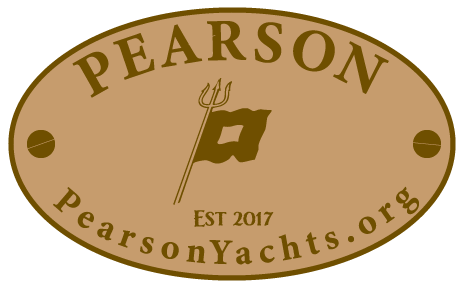- Register / Login
A password will be e-mailed to you

Reset Password

More information
Image gallery, floor plans.

Use the form below to contact us!
The Pearson 34 is a 33.78ft masthead sloop designed by William Shaw and built in fiberglass by Pearson Yachts between 1983 and 1986.
The Pearson 34 is a moderate weight sailboat which is a reasonably good performer. It is stable / stiff and has a low righting capability if capsized. It is best suited as a coastal cruiser. The fuel capacity is originally small. There is a short water supply range.
See all sailboats built by Pearson Yachts
See all sailboats designed by William Shaw

Pearson 34 for sale elsewhere on the web:

Main features
| Model | Pearson 34 | ||
| Length | 33.78 ft | ||
| Beam | 11.16 ft | ||
| Draft | 5.92 ft | ||
| Country | United states (North America) | ||
| Estimated price | $ 0 | ?? |
Login or register to personnalize this screen.
You will be able to pin external links of your choice.

See how Sailboatlab works in video
| Sail area / displ. | 17.60 | ||
| Ballast / displ. | 37.81 % | ||
| Displ. / length | 223.28 | ||
| Comfort ratio | 23.39 | ||
| Capsize | 2 |
| Hull type | Monohull fin keel with spade rudder | ||
| Construction | Fiberglass | ||
| Waterline length | 28.22 ft | ||
| Maximum draft | 5.92 ft | ||
| Displacement | 11240 lbs | ||
| Ballast | 4250 lbs | ||
| Hull speed | 7.12 knots |

We help you build your own hydraulic steering system - Lecomble & Schmitt
| Rigging | Masthead Sloop | ||
| Sail area (100%) | 550 sq.ft | ||
| Air draft | 48.75 ft | ||
| Sail area fore | 309.75 sq.ft | ||
| Sail area main | 239.56 sq.ft | ||
| I | 44.25 ft | ||
| J | 14 ft | ||
| P | 38.33 ft | ||
| E | 12.50 ft |
| Nb engines | 1 | ||
| Total power | 0 HP | ||
| Fuel capacity | 22 gals |
Accommodations
| Water capacity | 50 gals | ||
| Headroom | 0 ft | ||
| Nb of cabins | 0 | ||
| Nb of berths | 0 | ||
| Nb heads | 0 |
Builder data
| Builder | Pearson Yachts | ||
| Designer | William Shaw | ||
| First built | 1983 | ||
| Last built | 1986 | ||
| Number built | 0 | ?? |
Other photos

Modal Title
The content of your modal.
Personalize your sailboat data sheet
Great choice! Your favorites are temporarily saved for this session. Sign in to save them permanently, access them on any device, and receive relevant alerts.
- Sailboat Guide
Pearson 34 is a 33 ′ 9 ″ / 10.3 m monohull sailboat designed by William Shaw and built by Pearson Yachts between 1983 and 1986.

Rig and Sails
Auxilary power, accomodations, calculations.
The theoretical maximum speed that a displacement hull can move efficiently through the water is determined by it's waterline length and displacement. It may be unable to reach this speed if the boat is underpowered or heavily loaded, though it may exceed this speed given enough power. Read more.
Classic hull speed formula:
Hull Speed = 1.34 x √LWL
Max Speed/Length ratio = 8.26 ÷ Displacement/Length ratio .311 Hull Speed = Max Speed/Length ratio x √LWL
Sail Area / Displacement Ratio
A measure of the power of the sails relative to the weight of the boat. The higher the number, the higher the performance, but the harder the boat will be to handle. This ratio is a "non-dimensional" value that facilitates comparisons between boats of different types and sizes. Read more.
SA/D = SA ÷ (D ÷ 64) 2/3
- SA : Sail area in square feet, derived by adding the mainsail area to 100% of the foretriangle area (the lateral area above the deck between the mast and the forestay).
- D : Displacement in pounds.
Ballast / Displacement Ratio
A measure of the stability of a boat's hull that suggests how well a monohull will stand up to its sails. The ballast displacement ratio indicates how much of the weight of a boat is placed for maximum stability against capsizing and is an indicator of stiffness and resistance to capsize.
Ballast / Displacement * 100
Displacement / Length Ratio
A measure of the weight of the boat relative to it's length at the waterline. The higher a boat’s D/L ratio, the more easily it will carry a load and the more comfortable its motion will be. The lower a boat's ratio is, the less power it takes to drive the boat to its nominal hull speed or beyond. Read more.
D/L = (D ÷ 2240) ÷ (0.01 x LWL)³
- D: Displacement of the boat in pounds.
- LWL: Waterline length in feet
Comfort Ratio
This ratio assess how quickly and abruptly a boat’s hull reacts to waves in a significant seaway, these being the elements of a boat’s motion most likely to cause seasickness. Read more.
Comfort ratio = D ÷ (.65 x (.7 LWL + .3 LOA) x Beam 1.33 )
- D: Displacement of the boat in pounds
- LOA: Length overall in feet
- Beam: Width of boat at the widest point in feet
Capsize Screening Formula
This formula attempts to indicate whether a given boat might be too wide and light to readily right itself after being overturned in extreme conditions. Read more.
CSV = Beam ÷ ³√(D / 64)
Keel/CB version also available. Draft BD: 7.6’/BU: 3.83’ Temporarily reintroduced (1995?) under the short lived Cal-Pearson Corporation.
Embed this page on your own website by copying and pasting this code.

Discover Related Sailboats

Pearson 34-2
- About Sailboat Guide
©2024 Sea Time Tech, LLC
This site is protected by reCAPTCHA and the Google Privacy Policy and Terms of Service apply.
Pearson Yachts Portal
Welcome sailors.

Pearson Owners Website
Here you will find extensive information on boats built by Pearson Yachts Corporation, which is no longer in business.
Our goal is to preserve and enhance information for those sailing and maintaining classic plastic Pearson boats. The site is regularly updated as new information is discovered.
As many boat owners websites come and go on the internet, this site serves as a resilient portal for Pearson boat owners. It features a repository of enhanced original documentation from the builder. It integrates robust open source applications to insure privacy and security for users to register their boat information. The content found here is the result of owners contributions and internet research to document information on Pearson boats.
As a Web Portal [website] this is an intentional design that brings information together from diverse sources in a uniform way.

As a Web Portal this is a specifically designed web site that brings information together from diverse sources in a uniform way.

Pearson Yachts Brochure 1962

Pearson Yachts Brochure

We are Pearson owners and sailors who promote sharing information on the net by preserving original documentation and general sailing information in perpetuity. This information includes owners contributions of their expertise and experiences including an owners Froum and other documents or references to online resources.
"I established the non-profit domain pearsonyachts.org to create a common owners site which would be persistent on the internet. This is a volunteer effort to organize, share, and retain content. I hope you find the site informative and take the time to provide content and feedback." — Webmaster
Donations Appreciated
This site is a volunteer effort supported by contributions - a PayPal donate button is available at the bottom of the page for those willing and able to contribute of any amount. Thanks for your consideration!
Online Community - One Size Does Not Fit All
On this website you will find a content-driven Bulletin Board known as the Captains Forum where discussion topics are organized in logical boating categories, optimized for search and retrievel over time. Information is mined by the webmaster for inclusion in website content. We encourage all to register for this forum, where the profile information is stored in a secure database. As time allows the plan is to enhance the search capbilities to display additional boat information.
We have also provide social media links in the navigation bar for the Captains Forum, Facebook Pearson yachts, and the Google Pearson boats groups.
- Captains Forum
- Pearson Yachts
- Pearson Boats
Site Features
Pearson history.
A brief photo essay on the history of the Pearson Yachts Corporation, and reference links to several good Pearson articles on the web. Several factory brochures display the robust periods of boat production.
Parts references and technical articles with content such as boat design, hull number identification, and rig tuning.
Pearson Sailboats
A responsive table of all of the Pearson Sailboat models with search and sort capabilities and links to internet resources. There is a dedicated page on this site for each of the models that contains a factory brochure and more.
Boat Registry
The boat registry database utilizes the security and privacy settings of the member's profile. Specific boat owners information is part of that profile (Pearson model, hull number, home port, etc.).
Members Userid
Sign up with Forum registration to search and access the owners registry. It is a secure system with that will keep your personal identity (Email, etc) private.
Captains Forum
This is the Simple Machines™ Forum App that provides secure access to the Bulletin Boards. It contains specific boat categories for members to post questions, information, attachments, and other relavent topics.
Photo Gallery
This is the Coppermine™ Gallery App that serves as a database of photo albums based on vessel names or numbers. It allows members to create and add to their own albums.
Pearson Archives
These tables provide external links to the "pearsoninfo" archive site. That site is no longer supported so we are in the process of preserving as much of that information as possible on this site.

Pearson 34 Mk II
The Pearson 34 Mk II is a popular sailboat among sailors due to its comfortable accommodations, spaciousness, and durability. Measuring 34 feet in length, this boat was designed by Bill Shaw and produced by Pearson Yachts between 1989 and 1997. Its construction features a solid fiberglass hull with balsa cored decks and a lead keel, providing excellent stability and strength while sailing.
The interior of the Pearson 34 Mk II is well-appointed, offering ample space for a crew of up to six people. The main salon features a U-shaped dinette and settee that can convert into a double berth, while the forward cabin offers a V-berth with plenty of storage space. The galley is located on the starboard side and features a two-burner stove, a sink, and a refrigerator. The head compartment is situated aft and features a marine toilet, sink, and shower. Overall, the Pearson 34 Mk II is a versatile and reliable sailboat suitable for cruising, racing, or weekend getaways.
LOA: 34.50 ft LWL: 28.17 ft Beam: 11.50 ft Draft: 5.75 ft Displacement: 11500.00 lbs Ballast: 5800.00 lbs Hull type: Fin w/spade rudder Hull construction: FG Rigging type: Masthead Sloop
Pearson 34 Mk II for sale in the last 12 months
Looks like this is a boat rarely offered for sale - we could not find any listings in the last 12 months. Please come back and check at a later time or add this boat to your list to be notified if one is available for purchase.
Pearson 34 Mk II listing prices over time
Listing details.

COMMENTS
HS = 1.34 x √LWL (in feet) Pounds per Inch Immersion: The weight required to sink the yacht one inch. Calculated by multiplying the LWL area by 5.333 for sea water or 5.2 for fresh water. FOR MULTIHULLS ONLY: BN – Bruce Number: The Bruce Number is a power-to-weight ratio for relative speed potential for comparing two or more boats. It takes ...
Blue Water Surf Value Rank (BWSVR) 3769. Capsize Comfort Value Rank (CCVR)
The Pearson 34 will give you the accommodations and the easy handling that heighten the joys of cruising, in a boat also designed to be competitive and spirited for club racing. To get the speed we wanted, we designed the 34's hull shape to the external principles of hydrodynamics - not to racing rule considerations.
The Pearson 34 is a 33.78ft masthead sloop designed by William Shaw and built in fiberglass by Pearson Yachts between 1983 and 1986. The Pearson 34 is a moderate weight sailboat which is a reasonably good performer. It is stable / stiff and has a low righting capability if capsized. It is best suited as a coastal cruiser.
Pearson 34 is a 33′ 9″ / 10.3 m monohull sailboat designed by William Shaw and built by Pearson Yachts between 1983 and 1986. ... sailboatdata.com / CC BY. Embed
The technical storage or access is strictly necessary for the legitimate purpose of enabling the use of a specific service explicitly requested by the subscriber or user, or for the sole purpose of carrying out the transmission of a communication over an electronic communications network.
Founded by cousins, Clinton and Everett Pearson. It was the 28′ TRITON sailing auxiliary that put the company ‘on the map’. Before this they had been using the newfangled fiberglass construction materials to build dinghies and small power boats. At the request of Tom Potter, who worked for American Boat Building, the Pearsons set out to built a sailing auxiliary that would sell for under ...
Find Pearson 34 boats for sale in your area & across the world on YachtWorld. Offering the best selection of Pearson boats to choose from.
We are Pearson owners and sailors who promote sharing information on the net by preserving original documentation and general sailing information in perpetuity. This information includes owners contributions of their expertise and experiences including an owners Froum and other documents or references to online resources.
Overall, the Pearson 34 Mk II is a versatile and reliable sailboat suitable for cruising, racing, or weekend getaways. Specs LOA: 34.50 ft LWL: 28.17 ft Beam: 11.50 ft Draft: 5.75 ft Displacement: 11500.00 lbs Ballast: 5800.00 lbs Hull type: Fin w/spade rudder Hull construction: FG Rigging type: Masthead Sloop